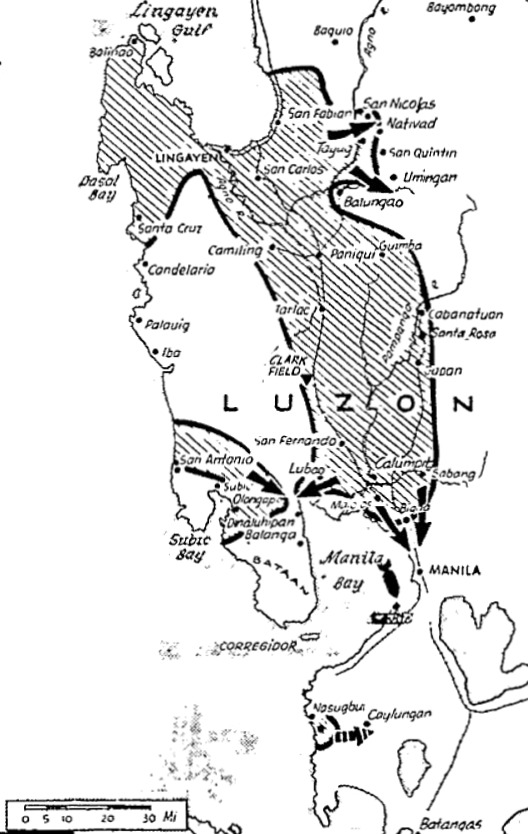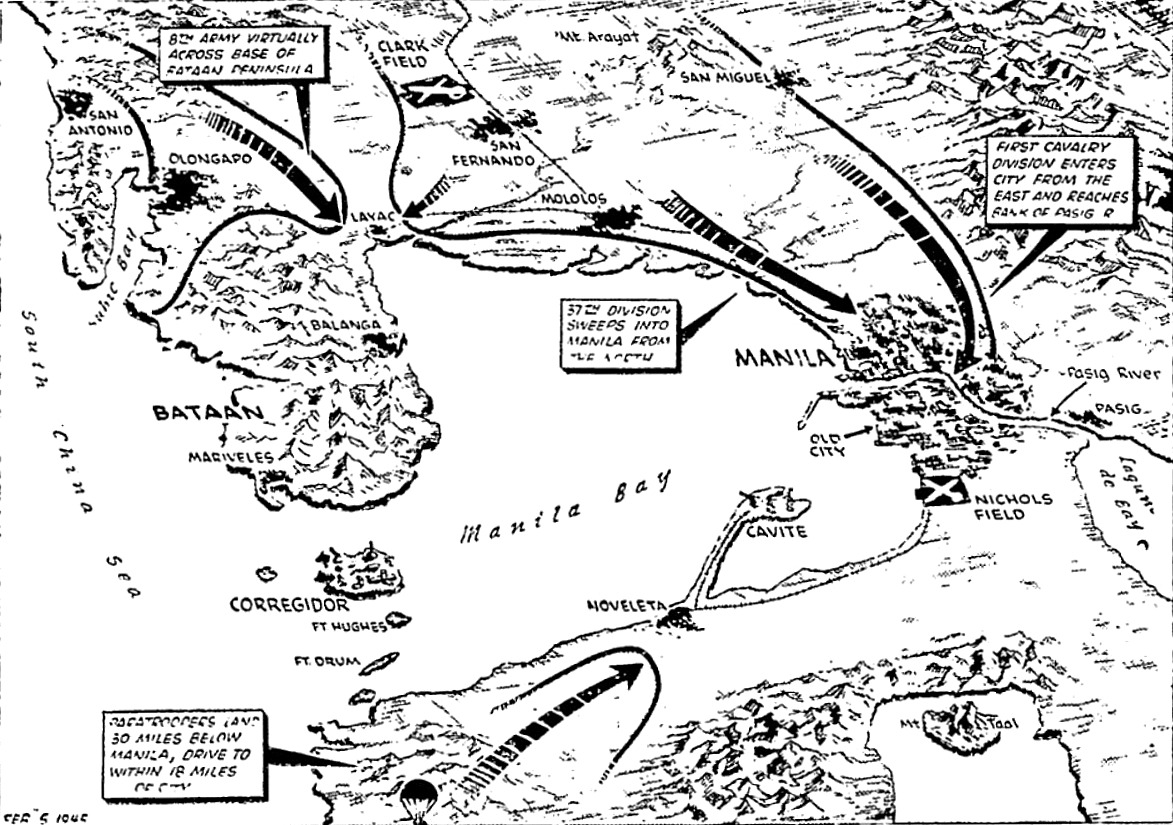The Pittsburgh Press (February 3, 1945)
Fall of city imminent –
Two U.S. divisions speed down highways to Manila
One force closes on town only 17½ miles north of Philippines capital
BULLETIN
GEN. MACARTHUR’S LUZON HQ, Philippines – Gen. Douglas MacArthur, in a visit to his frontline troops battling toward Manila, said today he believed that U.S. forces would reach the Philippines capital tomorrow.
A front dispatch said the Japs have started demolition fires in Manila.
GEN. MACARTHUR’S LUZON HQ, Philippines (UP) – Vanguards of two U.S. divisions today sped down parallel highways less than 20 miles north of Manila.
Liberation of the Philippines capital appeared imminent.
Japan’s three-year reign of terror and starvation in Manila was entering its last hours just 26 days after the landing of Gen. Douglas MacArthur’s liberating army on the shores of Lingayen Gulf, 110 miles to the north.
Caught off balance by the multiple American attacks and with their main forces pinned down impotently in the northern hills around Baguio, the Japs apparently had little or nothing to oppose the armored columns sweeping down on the capital.
Mett light resistance
Motorized outriders of the U.S. 37th Infantry and 1st Cavalry Divisions were meeting only scattered resistance in their parallel advance through the northern approaches to Manila, and there was every prospect that their battle flags would be raised over the city before the close of the weekend.
Official headquarters reports, admittedly lagging more than 36 hours behind the event, said the 37th Infantry Division had finally worked out of the swampy bottleneck at Calumpit and pushed on more than five miles down Highway 3 to the Malolos area, 17½ miles north of Manila, by Thursday night.
A few miles to the east, veteran troops of the 1st Cavalry Division were pushing down Highway 5 below Sabang, 23 miles north of Manila, after a breakneck 57-mile advance in 24 hours.
Capture Cabanatuan
The 1st Cavalry Division, entering the Battle of Luzon for the first time Wednesday night, struck eastward along the Manila north road from Guimba and then south into Highway 5.
Cabanatuan, Santa Rosa and Gapan all fell in swift succession, completely severing communications between the Jap forces in north and south Luzon. Strong armored patrols raced 24 miles past Gapan to reach Sabang by nightfall Thursday.
The stiffest Jap resistance was met at the Pampanga River crossings just above Cabanatuan, where some 300 enemy troops supported by light tanks put up a short, sharp battle that ended in their destruction almost to a man. U.S. losses in the fight were described officially as small.
The Manila-bound Yanks pushed past Cabanatuan without entering the prison camp six miles to the northeast from which 510 American and Allied captives were rescued last Tuesday.
The advance on Manila shook the puppet Philippines government into a frantic appeal for more planes, tanks and guns to bolster Lt. Gen. Tomoyuki Yamashita’s forces on Luzon.
Field dispatches said the terrific impetus attained by the 1st Cavalry Division was expected to carry them into Manila before the 37th Infantry Division, which had been hampered by the difficult terrain around Calumpit.
There were still no reports of Jap destruction inside Manila, and it was believed that only a relatively few key objectives – such as the Pasig River bridges, supply dumps and military installations – would be blown up before the enemy abandoned the capital.
Headquarters said plans are already being made for Gen. MacArthur and other high American officers to enter the city as soon as possible after its capture.
Far to the north, troops of the U.S. Sixth Army’s First Corps, who have borne the hardest fighting of the Luzon campaign, secured the Americans’ east flank between San Nicolas and Natividad, 27 miles inland from Lingayen Gulf and about the same distance south of Baguio.
Block road
Nine miles below Natividad, the Americans threw a block across Highway 8 just south of Umingan and launched an attack on sizeable Jap forces dug in on the outskirts of the town.
Meanwhile, elements of the newly-landed U.S. Eighth Army advanced six miles across the base of Bataan Peninsula east of Olongapo Thursday and were approaching Dinalupihan, where they were expected to effect a juncture with Sixth Army forces moving down from Highway 3.
Other Eighth Army units south of Manila were reported approaching Caylungon, 37 airline miles below the capital, after pushing nine miles inland from their invasion beachhead at Nasugbu Bay. Nasugbu town and Wawa, just to the north, were captured along with a nearby airfield, and headquarters said the Americans were meeting only light, sporadic resistance in their drive on Manila.
Japs attack convoy
Gen. MacArthur’s communiqué revealed that the Japs, repeating their unsuccessful Lingayen Gulf tactics, sent about 30 small boats equipped with depth charges and torpedoes against the Nasugbu invasion convoy Wednesday night. U.S. warships beat off the attack, destroying many of the enemy craft, and the convoy suffered only “minor damage,” the communiqué said.
Other U.S. naval patrols sank or severely damaged 19 enemy barges, five speedboats and a lugger in a night sweep along the northwestern coast of Luzon, and patrolling warplanes sank a Jap destroyer and damaged two others in another action farther north.
U.S. heavy bombers also dumped 109 tons of bombs on the Cavite Naval Base in Manila Bay, while another raiding force pounded enemy airfields in southern Formosa, destroying 30 grounded planes.


